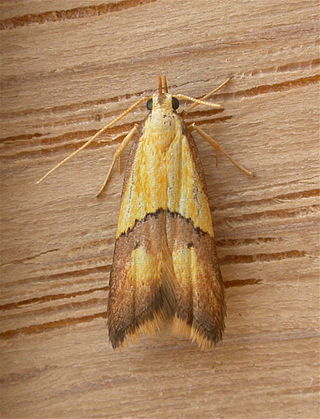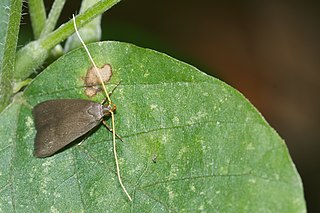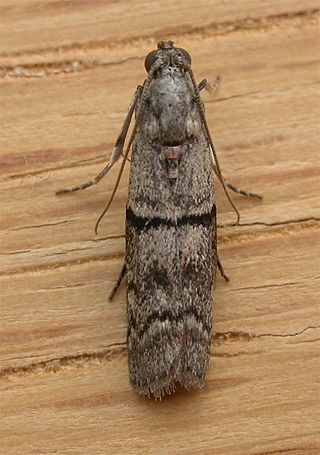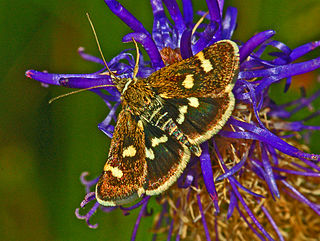Richard Amsel was an American illustrator and graphic designer. His career was brief but prolific, including movie posters, album covers, and magazine covers. His portrait of comedian Lily Tomlin for the cover of Time is now part of the permanent collection at the Smithsonian Institution. He was associated with TV Guide for thirteen years.

Pyraustinae is a large subfamily of the lepidopteran family Crambidae, the crambid snout moths. It currently includes about 1,280 species Most of them tropical but some found in temperate regions including both North America and Europe.
The Holcopogoninae are a subfamily of moths. They belong to the huge the superfamily Gelechioidea, of which they represent a minor but apparently quite distinct lineage.

The Lecithoceridae, or long-horned moths, are a family of small moths described by Simon Le Marchand in 1947. Although lecithocerids are found throughout the world, the great majority are found in the Indomalayan realm and the southern part of the Palaearctic realm.

The Lecithocerinae are a subfamily of small moths in the family Lecithoceridae. They are found worldwide, but most species occur in South Asia. The subfamily is characterized by the male genitalia with a bridge-like structure connecting the tegumen and the valva, and the uncus almost always is vestigial with two lobes at the dorsal base, only exceptionally united into a broad plate, but never as a thorn or spine.

Metasia is a genus of moths of the family Crambidae.

The Chrysauginae are a subfamily of snout moths. They are primarily Neotropical and include about 400 described species.

The Phycitini are a tribe of moths of the family Pyralidae.

The Anerastiini are a tribe of moths of the family Pyralidae.

Odontiinae is a subfamily of moths of the family Crambidae. The subfamily was described by Achille Guenée in 1854.

Glaphyriinae is a subfamily of the lepidopteran family Crambidae. It was described by William Trowbridge Merrifield Forbes in 1923. The subfamily currently comprises 509 species in 75 genera.
Turatia is a moth genus in the family Autostichidae.
The Torodorinae are a subfamily of small moths in the family Lecithoceridae.
Turatia turpicula is a moth in the family Autostichidae. It was described by László Anthony Gozmány in 2000. It is found in Namibia.
Turatia namibiella is a moth in the family Autostichidae. It was described by Georg Derra in 2011. It is found in Namibia.
Turatia scioneura is a moth in the family Autostichidae. It was described by Edward Meyrick in 1929. It is found in Sudan.
Hans Georg Amsel was a German entomologist with four publications ranging from 1951 to 1962. His home town was Cologne, although he frequently was in Kiel. His original job was in the banking industry, and he later worked in a bookstore. After quitting his job as bookstore worker, he decided to follow his heart and transfer to zoology, where he became an entomologist. His specific profession was studying Lepidoptera. "Soon after he was appointed as Head of Department of Entomology at the Colonial and Overseas museum called to Bremen, then rendered military service and, worked as a private scholar, he came as entomologist at the State Collections of Natural History in Karlsruhe," states a letter for his 60th birthday from the Journal of the Entomological Society of Vienna. During Amsel's career, he authored about twenty-six different Lepidoptera species and genera, and published four books.







